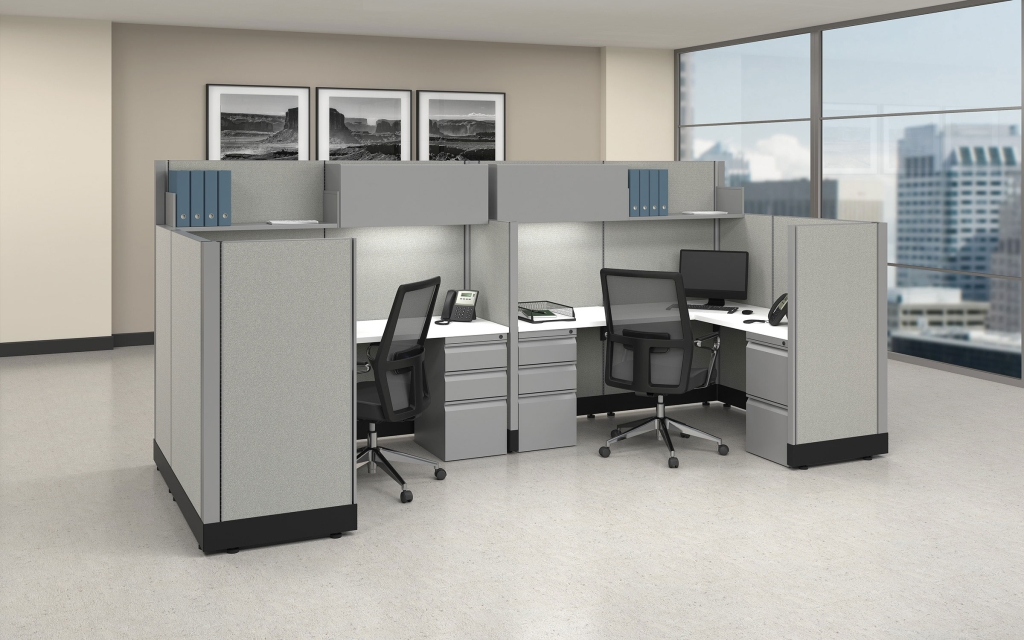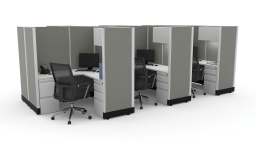
Cubicles
Offices have widely adopted the utilization of small partitioned enclosed settings, known as cubicles, as a convenient and efficient form of space allocation.
This article will focus on the concept of cubicles with emphasis on what they are, the benefits of having cubicles, the different types, how to set up a proper cubicle or workspace, and basic information about cubicle ownership.
An Introduction to Cubicles
A cubicle also referred to as a desk cubicle or an office cubicle, refers to a partially enclosed work area that is divided from other work areas by panels. These partitions usually have an average of five to six feet in height, which allows them to facilitate privacy, while employees remain aware of the other workers in the wider working environment. Cubicles provide flexibility through physical separation of the workplace which can be added to, removed from, or altered as required.
The Origins of Office Cubicles
The office cubicle can be traced back to the 1960s when the Herman Miller company developed and released what was called the Action Office System. The reason for this innovation was to encourage greater flexibility and privacy within a workspace in contrast to open-concept office spaces. Over the years, the idea of cubicles has shifted to accommodate the needs of businesses and their employees, and with that, has come to define the modern workspace.
Benefits of Cubicles
Several benefits come with cubicles, many of which have been touted by modern cubicle proponents for years. There are various advantages of cubicles, but one of the most important is that they offer privacy. The partitions enable effective minimization of interruption through visual and sound barriers which prevent employees from constant distraction. Other benefits include:
- Newer and more modern work philosophies tout the use of open walls, which pose problems such as noise pollution that can hinder efficiency. Cubicles on the other hand contain miniature acoustic barriers that reduce and dampen sound, thus reducing general noise levels.
- The organizational structure of cubicles is designed to allow employees their own space. This increases employee morale and decreases turnover because employees can bring decor items to the office and decorate their cubicle areas, adding personalization to an otherwise stark workspace [1]
- Cubicles are much cheaper when compared to constructing and designing small offices that can accommodate each worker. They need comparatively few modifications and are easily convertible to meet any future needs of the office.
- Cubicles are highly flexible as they can be easily adapted and rearranged in many ways whenever there is a need. Whether expanding or redesigning workspaces for increased efficiency, office cubicles are easier to relocate and reconfigure.
- Finally, their ease of design and installation allows for the effective use of all office space, free from unnecessary hindrances. They can be easily adjusted to the layout of any office necessary for a large number of stations, without the feeling of clutter.
Different Types of Cubicles
There are various kinds of cubicles that can be purchased as systems, or customized according to the needs of the company.
Standard Cubicles
The most traditional type of desk cubicle is enclosed with three partitions, one on the front of the desk and the other two on either side of the desk. Some key features are desk space, cabinets and drawers for storage, and shelves for decor and pictures. These are perfect for jobs that are likely to require a lot of concentration and not much interaction.
Modular Cubicles
Modular cubicles present greater possibilities because they can be transformed depending on the specific tasks and workers' preferences. This ranges from the frequent use of rearrangeable components offering greater flexibility concerning the design and use of the cubicle system in the workplace.
High & Low-Wall Cubicles
Low-wall cubicles ensure people work closer with one another than the previous types, as they have shorter partitions while still offering some measure of privacy. They can also be applied in organizational settings requiring a team problem-solving approach. High-wall cubicles have tall dividers, allowing fewer outside noises and interruptions, which are especially suitable for employees who work on complex tasks and need minimum interferences. [2]
Cubicle Workstations
Office spaces usually organize desks in group settings; employers often use cubicle workstations, also known as two- to six-person cubicles, that comprise several workstations in one area. They include cubicles that are connected by a single partition and may feature open brainstorming, and collaboration spaces, which are great when organizing group projects and discussions.
Sit-Stand Cubicles
Finally, sit-stand cubicles reduce sitting time and increase the standardization of posture to enhance the health and output of the employees. These utilize desks that can be raised to standing height or lowered for sitting at any point throughout the workday. Height-adjustable chairs and monitor arms, are typically used to add ergonomic comfort and adjustability to sit-stand cubicles.
Call Center Cubicles
How to Design an Efficient Cubicle Workspace
Designing an optimal work area within a cubicle requires several strategies to be implemented from the design level to the final touches. To start, desks should be organized for convenience while using them; ensure the things you need to access frequently are within reach, and take advantage of vertical space with cubicle shelves or organizers.
Space
Sufficient space should be provided around the area where office cubicles are located to allow free movement without having to navigate through unnecessary clutter in the form of furniture and other equipment.
Ergonomics
Designing a workspace is a critical process, and it cannot be completed without the incorporation of quality ergonomics. Ergonomic office furniture supports the correct posture through the use of specially designed features that are adjustable to a body's structure. Choose an ergonomic chair with the right height and back support. Position the desk so that when typing, arms are parallel to the floor, and feet either touch the floor or a footrest. It is also advisable to place your computer monitor in an upright position to avoid straining the neck and eyes; the screen should be approximately at an arm’s distance from the face. [3]
A certain level of order is fundamental in creating a proper work environment. It is advisable to remove clutter from the environment and organize the desk using trays, holders, and file cabinets. Utilize cable management systems to ensure that wires and cords do not clutter the working area. This creates a neater look and prevents tripping over wires or causing damage to other equipment.
A good source of light in a desk cubicle in the form of a desk or floor lamp can help workers avoid squinting and give them control over the light in their cubicles.
Finally, cubicles can be used to display decorative items such as photos, artwork, and plants, among other things, which can change an employee's level of workspace personalization and positively affect productivity.
How to Integrate Technology Into Cubicles
Another element to consider in a modern cubicle is technology integration. Buy quality keyboards and mice that are ergonomic, and if using a laptop, ensure that it's used in conjunction with a laptop stand. Employ software technologies for charging devices more efficiently like under-desk power outlets and power banks.
Extra Information About Cubicles
Here is some basic information about cubicle systems. Cubicle partitions can be made of fabric-covered panels, glass, and laminated wood. The choice of material can impact sound, style, and durability.
Office desks and storage units that are made to furnish the cubicles are commonly constructed using either wood or metal with or without treatment, to match the overall outlook of the cubicle. This is because it is crucial to clean surfaces and partitions frequently to help decrease the spread of germs.
Typically individual cubicle parts can be replaced, which saves time, money and allows the cubicle to last longer. [4]
More recent trends in cubicle systems include sustainability, with the utilization of eco-friendly products in cubicle design, with a majority of modern cubicle components already being made from recycled materials. This decreases harmful effects on the environment and gives offices a more conscious furnishing option.
Modern office partitions are more stylish than in previous decades and come in different colors, and styles to make offices more aesthetically appealing.
Conclusion
Cubicles are an essential part of the modern work environment and design and affect organizational life greatly. They provide a fairly easy and cheap way of creating workplace order, ensuring privacy, minimizing noise, and optimizing performance.
Businesses can establish an efficient and effective organization of work areas if they familiarize themselves with various types of cubicles and effective ways of designing a workspace that prioritizes productivity and rest.
Cubicles continue to be one of the most viable office furnishing options since the requirements of the modern workplace are seldom static.
Images
Sub-topics
Related-topics
References
- Celebslife [ Office Cubicle Hacks: Organize And Personalize Your Workspace ] Aug 06, 2024
- Uberant [ How Cubicles can maximize the use of your office space ] Aug 06, 2024
- ICTSD [ Unlocking Productivity: The Impact of Furniture on Your Business ] Aug 06, 2024
- Fullform ADDA [ Cubicle Revival: Transforming Traditional Workspaces ] Aug 06, 2024
Contributors
Last Modified: August 16, 2024
